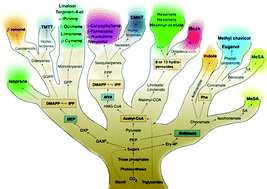Covering: 1989 to February 2011
Plant volatiles typically occur as a complex mixture of low-molecular weight lipophilic compounds derived from different biosynthetic pathways, and are seemingly produced as part of a defense strategy against biotic and abiotic stress, as well as contributing to various physiological functions of the producer organism. The biochemistry and molecular biology of plant volatiles is complex, and involves the interplay of several biochemical pathways and hundreds of genes. All plants are able to store and emit volatile organic compounds (VOCs), but the process shows remarkable genotypic variation and phenotypic plasticity. From a physiological standpoint, plant volatiles are involved in three critical processes, namely plant–plant interaction, the signaling between symbiotic organisms, and the attraction of pollinating insects. Their role in these “housekeeping” activities underlies agricultural applications that range from the search for sustainable methods for pest control to the production of flavors and fragrances. On the other hand, there is also growing evidence that VOCs are endowed with a range of biological activities in mammals, and that they represent a substantially under-exploited and still largely untapped source of novel drugs and drug leads. This review summarizes recent major developments in the study of biosynthesis, ecological functions and medicinal applications of plant VOCs.

You have access to this article
 Please wait while we load your content...
Something went wrong. Try again?
Please wait while we load your content...
Something went wrong. Try again?


 Please wait while we load your content...
Please wait while we load your content...